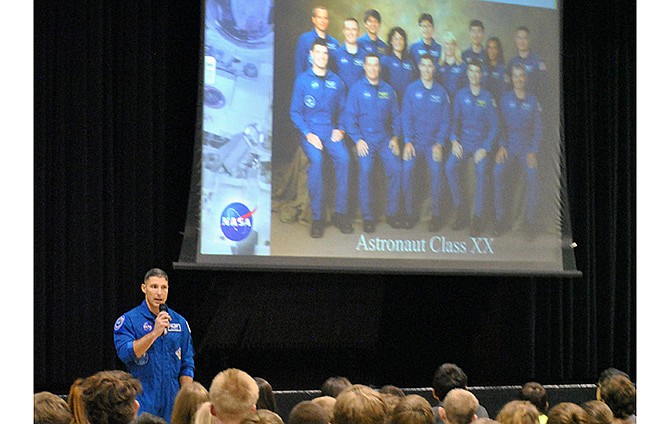When Osage Middle School (OMS) student Aly Baker asked U.S. astronaut Col. Michael Hopkins if he ever thought he'd be what he is today, Hopkins gave a resounding "no."
Hopkins grew up on a farm near Richland, Mo., just down the road from his alma mater, School of the Osage, where he was involved in a variety of sports, including football, basketball and track.
He said his interest in space sparked while attending Osage High School during the early days of NASA's space shuttle program.
"Back then, we would watch the launches of the space shuttle during an assembly and got to see the astronauts launching on the shuttle," he said.
Hopkins, a 1987 Osage graduate, went on to enjoy a successful career in the U.S. Air Force and eventually became a U.S. astronaut for NASA, spending 166 days aboard the International Space Station about a year ago.
Hopkins shared his story on becoming an astronaut along with his trip in space as the keynote speaker during Friday's opening assembly at the Osage Science Day at the middle school in Kaiser.
Along with Hopkins, the event, organized by the OMS science department, featured speeches from other science professionals, including a university professor from Rolla and a representative from the MU Extension.
"We have Osage Science Day every three years, with Pi Day, exploring math, and Cultural Day also held," said sixth-grade science teacher Lana Thompson.
Students spent time in breakout sessions with the professionals, learning all the ins and outs of their fields along with the future of scientific development.
In one session, Hopkins shared pictures and information about various scientific experiments from his time aboard the International Space Station. He discussed watching plant growth in a space environment, the effects of lightning in the atmosphere and how water interacts with no gravity pull in space.
Hopkins first captivated students, though, during the day's opening assembly with his journey to space and becoming one of only 337 NASA astronauts from the U.S.
Hopkins said after high school, he attended University of Illinois where played football for the Fighting Illini and received a bachelor's degree in aerospace engineering. He then received a master's degree in the same field from Stanford University in 1992.
He later joined the U.S. Air Force where he served in advanced space system technologies at Kirtland Air Force Base, worked at the Canadian Flight Test Center, was a project engineer and program director for the U.S. Air Force Rapid Capabilities Office at the Pentagon and served as a special assistant to the vice chairman of the Joint Chiefs of Staff.
About three years into his Air Force career, Hopkins said he started applying for the astronaut program. In 1998, he submitted his application, receiving his first rejection letter from NASA. Two years later, he applied again, receiving his second rejection letter. He tried a third time four years later with the same result.
"It wasn't until 2009, four tries over 13 years before I got accepted by NASA," he said. "It is a lesson that if you have a dream, keep following it and don't ever give up on it because you never know what is going to happen. That was certainly the case for me."
Hopkins was one of nine U.S. astronauts selected out of 3,500 applications for NASA's 20th astronaut class.
On Sept. 25, 2013, Hopkins joined two Russian cosmonauts, Oleg Kotov and Sergey Ryazanskiy, in flight to the International Space Station, where he orbited for 166 days before returning to Earth on March 10, 2014.
Hopkins detailed his eight-minute, 53-second flight through the Earth's atmosphere to space, the 13-hour process of getting aboard the International Space Station and his time with the five other astronauts and cosmonauts maintaining the space station, performing experiments, sharing camaraderie and capturing photos and video of the one-of-a-kind view from space.
Though a once in a lifetime experience, Hopkins discussed the challenges of being away from his family, though he was able to speak on the phone often with loved ones, including video conferencing his wife, Julie, and two sons once a week, and even watching his sons' hockey games live from space.
Hopkins discussed the types of exercise he and his fellow astronauts performed, the food they ate and the feeling and adjustments made to move around without gravity. He also talked about "space walking" miles outside the Earth's atmosphere in order to fix or maintain equipment on the actual space station.
Following his detailed description of life as a U.S. astronaut in space, Hopkins answered a variety of questions from students and offered advice for any future astronauts or those interested in the science field in general.
"Find something you love and you are passionate about," he said, noting his Air Force career was one he loved. However, he also kept pursuing his goal to be an astronaut.
"The chances of being an astronaut are small. It doesn't have anything to do with your talent level or your abilities. ... there are a lot of people out there that would be a fantastic astronaut ... find what you love and do the best you can."

